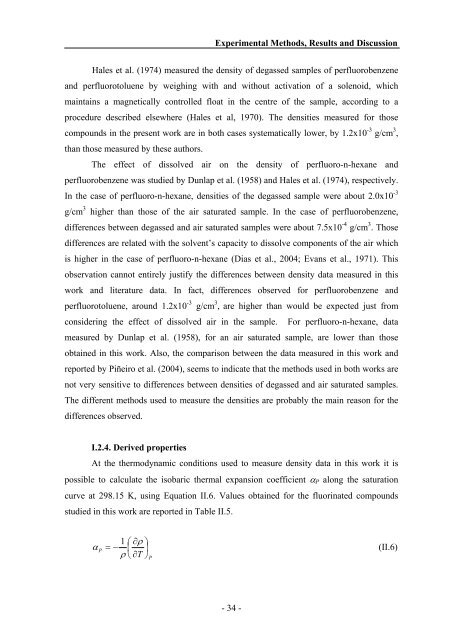n - PATh :.: Process and Product Applied Thermodynamics research ...
n - PATh :.: Process and Product Applied Thermodynamics research ...
n - PATh :.: Process and Product Applied Thermodynamics research ...
You also want an ePaper? Increase the reach of your titles
YUMPU automatically turns print PDFs into web optimized ePapers that Google loves.
Experimental Methods, Results <strong>and</strong> Discussion<br />
Hales et al. (1974) measured the density of degassed samples of perfluorobenzene<br />
<strong>and</strong> perfluorotoluene by weighing with <strong>and</strong> without activation of a solenoid, which<br />
maintains a magnetically controlled float in the centre of the sample, according to a<br />
procedure described elsewhere (Hales et al, 1970). The densities measured for those<br />
compounds in the present work are in both cases systematically lower, by 1.2x10 -3 g/cm 3 ,<br />
than those measured by these authors.<br />
The effect of dissolved air on the density of perfluoro-n-hexane <strong>and</strong><br />
perfluorobenzene was studied by Dunlap et al. (1958) <strong>and</strong> Hales et al. (1974), respectively.<br />
In the case of perfluoro-n-hexane, densities of the degassed sample were about 2.0x10 -3<br />
g/cm 3 higher than those of the air saturated sample. In the case of perfluorobenzene,<br />
differences between degassed <strong>and</strong> air saturated samples were about 7.5x10 -4 g/cm 3 . Those<br />
differences are related with the solvent’s capacity to dissolve components of the air which<br />
is higher in the case of perfluoro-n-hexane (Dias et al., 2004; Evans et al., 1971). This<br />
observation cannot entirely justify the differences between density data measured in this<br />
work <strong>and</strong> literature data. In fact, differences observed for perfluorobenzene <strong>and</strong><br />
perfluorotoluene, around 1.2x10 -3 g/cm 3 , are higher than would be expected just from<br />
considering the effect of dissolved air in the sample. For perfluoro-n-hexane, data<br />
measured by Dunlap et al. (1958), for an air saturated sample, are lower than those<br />
obtained in this work. Also, the comparison between the data measured in this work <strong>and</strong><br />
reported by Piñeiro et al. (2004), seems to indicate that the methods used in both works are<br />
not very sensitive to differences between densities of degassed <strong>and</strong> air saturated samples.<br />
The different methods used to measure the densities are probably the main reason for the<br />
differences observed.<br />
I.2.4. Derived properties<br />
At the thermodynamic conditions used to measure density data in this work it is<br />
possible to calculate the isobaric thermal expansion coefficient αP along the saturation<br />
curve at 298.15 K, using Equation II.6. Values obtained for the fluorinated compounds<br />
studied in this work are reported in Table II.5.<br />
P<br />
T ⎟ 1 ⎛ ∂ρ<br />
⎞<br />
α = − ⎜<br />
ρ ⎝ ∂ ⎠<br />
P<br />
- 34 -<br />
(II.6)



